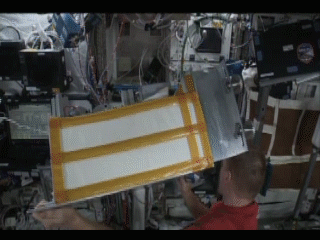ISS - International Space Station logo.
April 12, 2016
International Space Station (ISS). Image Credit: NASA
(Highlights: Week of March 28, 2016) - Investigations on the International Space Station this week focused on the kind of soil we may find while exploring our solar system and how we are turning to a lizard found on Earth for better adhesives to use in space.
ESA (European Space Agency) astronaut Tim Peake completed setup of the Strata-1 study investigating the properties and behavior of regolith in microgravity, in preparation for the upcoming activation. Regolith is the "soil" made up of dust and broken rock found on asteroids, comets, the moon and other airless worlds. It is different from the dirt on Earth in that it contains no living material. Sealed tubes of simulated regolith were delivered to the station and will be subjected to microgravity and the ambient vibration of the orbiting laboratory. Any changes will be recorded on video images relayed to the Strata-1 team at NASA's Johnson Space Center in Houston.
Image above: Crew members on the International Space Station captured this unique cloud formations during orbit. Image Credit: NASA.
Scientists believe Strata-1 will give us answers about how easy or difficult it will be to anchor a spacecraft in regolith, how it will react to spacecraft and spacesuit materials and how to safely move and process large volumes of regolith once we reach the surface of these bodies. Results may also apply to mixing of dry materials on Earth, such as pharmaceuticals, or the study of dune migration and dynamics.
NASA astronaut Jeff Williams completed a round of tests for the Gecko Gripper investigation. This demonstration tests an adhesive gripping device much like what is found on the toes of a gecko. These lizards have special hair on their feet called setae that let them stick to vertical surfaces without falling. This NASA investigation tests a device that engineers believe will stick to surfaces in the space environment. The technology promises to enable many new capabilities including robotic crawlers working on spacecraft exteriors or grippers using a touch-to-stick method to capture and release objects such as orbital debris. Robots using this adhesive to climb walls also have military and security applications on Earth. The machining industry could also use the technology, handling fragile or lightweight objects like glass, boxes or bags.
Anomation above: ESA (European Space Agency) Tim Peake installed the Strata-1 investigation on the International Space Station. The study looks in to how regolith -- the dirt found on asteroids, moons and other planets -- would react in microgravity. Image Credit: NASA.
Peake installed two protein crystal growth canisters to continue the JAXA (Japan Aerospace Exploration Agency) High Quality Protein Crystal Growth (JAXA PCG) experiment. The canisters were installed in the Protein Crystal Research Facility (PCRF). The crystals will grow for about seven weeks as scientists look more closely at the structures of protein crystals grown in microgravity and search for methods to improve their quality.
Protein crystals have been grown in space for many years and the benefits are widespread. Detailed analysis of high quality protein crystal structures is useful in designing new pharmaceuticals for diseases and contributes to a range of commercial aspects including industrial and energy sectors.
Principal investigators announced the successful completion of NASA's Advanced Colloid Experiment - Heated 2 (ACE-H-2) investigation. This investigation studies charged nanoparticles in a colloid stored in the Fluid Integration Rack, allowing for crystallization and self-assembly to stabilize and create an even concentration of the mixture.
Image above: A view of the contents of two of Strata-1's tubes. The regolith simulant on the left is a simplified model consisting of angular fragments of colored glass, sorted into three sizes. The tube on the right contains pulverized meteorite material to closely resemble the actual regolith on a small asteroid, also sorted into three sizes. Image Credit: NASA.
Many household cleaning products are a special kind of liquid called a colloid — a mixture of liquid with minuscule particles floating in it. In the orbiting laboratory, gravity isn’t weighing down the particles and changing the concentration of the mixture, so scientists can better study colloids. Scientists want to use the microgravity environment to discover how the crystalline structures are formed and investigate the nanoparticle concentration. The investigation could help scientists and engineers design advanced materials and sensors with submicron features.
Human research investigations conducted this week included Biochem Profile, Cardio Ox, Marrow, Repository, Circadian Rhythms, Cognition, Dose Tracker, Fine Motor Skills, Habitability, Multi-Omics, Sprint, and Space Headaches.
Space Station Live: Getting a Grip on the Space Station
Video above: NASA Commentator Lori Meggs at the Marshall Space Flight Center talks to Aaron Parness, the principal investigator for the Gecko Gripper experiment, an adhesive technology inspired by nature. The Gecko Gripper can stick to a surface on command, and is being considered as a way to enable new capabilities in space such as reusable sensor mounts and robotic crawlers that could walk along spacecraft surfaces inside and out.
Progress made on other investigations and facilities this week include Cell Mechanosensing-3, NanoRacks Module-48, Rodent Research-3, FLEX-2, EPO Peake, ISS Ham, AMS-02, Cell Biology Experiment Facility, EFU Adapter, and HRF-2.
Related links:
Strata-1 study: http://www.nasa.gov/mission_pages/station/research/experiments/2146.html
Gecko Gripper investigation: http://www.nasa.gov/mission_pages/station/research/experiments/2324.html
High Quality Protein Crystal Growth (JAXA PCG) experiment: http://www.nasa.gov/mission_pages/station/research/experiments/157.html
NASA's Advanced Colloid Experiment - Heated 2 (ACE-H-2) investigation: http://www.nasa.gov/mission_pages/station/research/experiments/1267.html
Cell Mechanosensing-3: http://www.nasa.gov/mission_pages/station/research/experiments/1207.html
Rodent Research-3: http://www.nasa.gov/mission_pages/station/research/experiments/1722.html
EPO Peake: http://www.nasa.gov/mission_pages/station/research/experiments/1977.html
ISS Ham: http://www.nasa.gov/mission_pages/station/research/experiments/346.html
AMS-02: http://www.nasa.gov/mission_pages/station/research/experiments/742.html
Space Headaches: http://www.nasa.gov/mission_pages/station/research/experiments/181.html
Sprint: http://www.nasa.gov/mission_pages/station/research/experiments/972.html
Fine Motor Skills: http://www.nasa.gov/mission_pages/station/research/experiments/1767.html
Dose Tracker: http://www.nasa.gov/mission_pages/station/research/experiments/1933.html
Habitability: http://www.nasa.gov/mission_pages/station/research/experiments/1772.html
Circadian Rhythms: http://www.nasa.gov/mission_pages/station/research/experiments/892.html
International Space Station (ISS): https://www.nasa.gov/mission_pages/station/main/index.html
Space Station Research and Technology: https://www.nasa.gov/mission_pages/station/research/index.html
European Space Agency (ESA): http://www.esa.int/ESA
Japan Aerospace Exploration Agency (JAXA): http://global.jaxa.jp/
Images (mentioned), Animation (mentioned), Video, Text, Credits: NASA/Kristine Rainey/Lead Increment Scientist Expeditions 47 & 48/Yuri Guinart-Ramirez.
Best regards, Orbiter.ch





